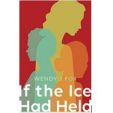The title of this layered and compassionate novel echoes a question that is often asked in the wake of a tragedy: “How might things have been different if _____ hadn’t occurred?” While the novel considers such what-ifs, it is mainly concerned with real consequences–in particular, the ways in which a tragic, unexpected loss upends the plans and dreams of the people it affects, leaving them to try to reassemble their broken lives. By weaving together the stories of multiple characters who are affected by such a loss, Fox portrays this process with insight and empathy, and shows how it can deliver unanticipated gifts.
The tragedy at the heart of the novel is the death of a teenager, Sammy Henderson, who while making his way from the home of his girlfriend, Irene, to the basketball game of his sister, Kathleen, takes a shortcut across a frozen river and falls through the ice. Sammy had recently learned, and Kathleen soon discovers, that Irene is expecting his child, a circumstance that will end up forming a lasting connection between the two women.
Although Fox writes from the point of view of both Irene and Kathleen and flashes back to their pasts, the primary voice in the novel is that of Melanie, the child that Irene gives birth to but that Kathleen raises, largely for practical reasons (Kathleen is a few years older than 14-year-old Irene and has a large, supportive family to rely on). In the present tense of the novel, Melanie, who has always believed that Kathleen is her biological mother, is a 33-year-old market analyst for a software company. One benefit of her job is travel, which gives her opportunities for sex without the burden of commitment, because the trysts are mostly with married men. It is as if Melanie is relishing the sow-your-wild oats kind of freedom that early motherhood ruled out for Kathleen.
Melanie doesn’t seem close to falling in love with any of the men she hooks up with; in fact, she’s often irritated with them, justifiably. When one of these men expresses displeasure with the burdens of fatherhood, she thinks, “[I]f he gave two shits about his kids, he would spend more time with them.” This echoes Melanie’s feelings about the man, Andrew, she’d assumed was her father, and who left Kathleen and Melanie when Melanie was a child. Later in the novel, as Fox weaves in more of Kathleen’s and Irene’s stories, she conveys how Andrew was deceived about Melanie’s parentage, allowing us to see him in a more sympathetic light. This layering of diverse stories and perceptions, a key feature of the novel, results in nuanced portrayals of characters and circumstances, making it impossible to categorize anyone as purely good or bad. This complexity feels true to life, and it makes for a gratifying read.
One of the most the most compelling aspects of the novel is the bond that forms first between Kathleen and Irene and later between these women and Melanie. After Sammy’s death, when Kathleen learns that Irene is expecting his child, she looks out for Irene, understanding that her mother is gone and her father rather distant. At first, Kathleen’s efforts seem mainly a way for her to maintain a connection with Sammy, but over time, she and Kathleen form a deep, familial connection. As Irene observes, “They’d been made sisters, and Mel belonged to both of them.” Although Kathleen becomes known as Melanie’s mother, Irene is essentially a co-parent, becoming as close to Melanie as she is to Kathleen.
This is not to say that the novel doesn’t acknowledge the dreams that Kathleen and Irene set aside in the wake of Sammy’s death: for Kathleen, the possibility of a more adventurous life beyond their small town, which young motherhood ruled out; for Irene, a marriage to Sammy, who had been looking forward to their future and to fatherhood. Yet the story of the relationship between Kathleen and Irene, and later between both women and Melanie, suggests that not all consequences of tragedies are dark–that efforts to rebuild one’s life can sometimes deliver lasting gifts.
It’s important to note that the novel extends beyond Melanie, Kathleen, and Irene, exploring other lives and incidents that ultimately connect back to the three women. For example, a tragedy preceding Sammy’s death alters the lives of several people linked to the women by blood or circumstance. One of these people, Lucy Estelle, happens to be a cousin to Irene and the mother-in-law of one of Melanie’s romantic interests. Toward the end of the novel, Lucy Estelle precipitates a crisis that could have dire consequences for Melanie, Kathleen, and Irene and whose outcome shows the power of empathy, hope, and forgiveness.
A kind of suspense is built into the very structure of If the Ice Had Held. When I was first introduced to Melanie and the other characters, I had a sense that connections would develop between their stories. But I wasn’t clear on just how. As I read further, I became more and more invested in each character and storyline and more and more eager to see how they would intersect. When they started to, I found it nearly impossible to put the book down.
A final note: I’ve also reviewed Wendy J. Fox’s story collection The Seven Stages of Anger and her first novel, The Pull of It. I highly recommend both books.
Would My Pick be Your Pick?
If you're interested in ________, the answer may be "Yes":▪ Epic novels about families and communities
▪ Stories about coping with loss or tragedy
▪ Narratives that examine child-parent or child-parent figure bonds






